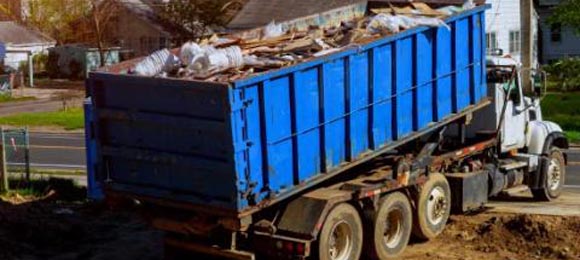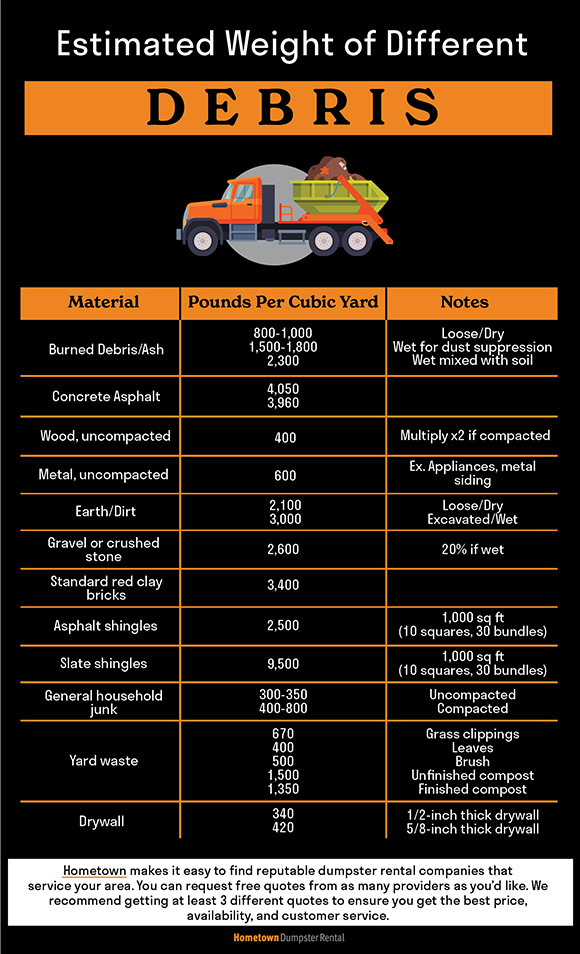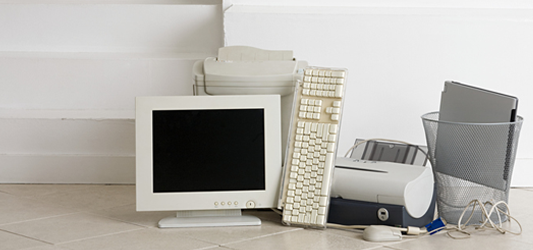
Updated July 15, 2025
When renting a dumpster, it’s easy to focus on the size you need and forget about one crucial factor: weight limits.
Most dumpster rentals come with a set weight allowance, and going over it can lead to unexpected overage fees that quickly add up. Whether you’re tackling a home cleanout, renovation, or construction project, having a good estimate of your dumpster load’s weight can help you stay within budget and avoid surprises on your final bill.
In this guide, we’ll break down how to estimate the weight of different types of debris, how much weight common dumpster sizes can hold, and tips to avoid exceeding your limit.
We'll go over:
- What Is an Overage Fee?
- How Do I Calculate the Weight of Debris and Junk?
- How Much Does the Waste in a Dumpster Weigh?
- What If I'm Still Unsure How Much My Junk or Debris Will Weigh?
- How to Find the Best Dumpster Rentals
Easily compare local dumpster prices
Request availability and pricing from dumpster
rental companies near you.

What Is an Overage Fee?
An overage charge is an additional fee that is added to the final bill if the weight of a dumpster load exceeds its weight allowance. Overage fees vary by company but typically range from $50 per ton to $100+ per ton.
Let's say you contact a dumpster company and they quote you $400 to rent a 20 yard dumpster with an included 2-ton (4,000 lb) weight allowance. The dumpster rental company states there is a $50 per ton charge for going over your 2-ton weight limit. After filling the dumpster and having it hauled away, the dumpster rental company weighs the load at the landfill and finds it is 1,000 lbs over the weight allowance. In this scenario, you will incur a $50 additional charge on your bill, so your total bill is now $450.
Note that the overage doesn’t have to be a full 2,000 lbs (1 ton) over the weight allowance in order to be charged the full amount ($50 in this example). Many dumpster rental companies charge overage fees this way, while others offer prorated overage fees.
Common Weight Allowances by Dumpster Size:
- 10 yard: 2 tons (4,000 lbs)
- 20 yard: 4 tons (8,000 lbs)
- 30 yard: 4 tons (8,000 lbs)
- 40 yard: 6 tons (12,000 lbs)
As previously mentioned, weight allowances vary by dumpster rental provider. Reach out to them directly to get the most accurate and up-to-date cost info.
Keep reading:
- A Comprehensive Guide to Dumpster Weight Limits
- How Much Weight Can a 20 Yard Dumpster Hold?
- Top 6 Ways to Avoid Dumpster Overage Fees
How Do I Calculate the Weight of Debris or Junk?
The weight of dumpster loads can vary a great deal. For instance, a 10 yard dumpster filled to the top with cabinets and linoleum flooring will weigh far less than a 10 yard dumpster filled with stone or masonry debris.
The estimated weights in the chart below are per cubic yard.
It may be helpful to keep in mind that one cubic yard measures 3 ft x 3 ft x 3 ft in size, which is roughly the same dimensions as a standard kitchen stove.
Average Weight of Common Debris
|
Material
|
Pounds Per Cubic Yard
|
Notes |
|---|---|---|
|
Burned debris/Ash |
800-1,000 |
Loose/dry |
|
Concrete |
4,050 |
|
|
Wood, un-compacted |
400 |
Multiply x2 if compacted |
|
Metals, un-compacted |
600 |
Ex. Appliances, metal siding |
|
Earth/Dirt |
2,100 |
Loose/dry |
|
Gravel or crushed stone |
2,600 |
20% more if wet |
|
Standard red clay bricks |
3,400 |
|
|
Asphalt shingles |
2,500 |
1,000 sq ft (10 squares, 30 bundles) |
|
General household junk |
300-350 |
Un-compacted |
|
Yard waste |
670 |
Glass clippings |
|
Drywall |
340 |
1/2-inch thick drywall |
Reminder: These are averages, and the exact weight of your debris may be more less.
It's important to remember that volume does not necessarily dictate the weight of a load. For example, a 10 yard dumpster filled to the top with household furniture will likely weigh less than a 10 yard dumpster filled one-fifth of the way full of concrete debris. Wet debris weighs significantly more than dry wastes, which is why we advise covering the dumpster with a tarp during rainstorms to avoid saturating the load.
Estimating the weight of your junk or debris can be particularly tricky if multiple types of waste are disposed of in the dumpster.
Using this formula to help keep a running estimate of what enters the dumpster is a useful strategy to keep the load under the weight allowance:
(Weight of 1 yard of a particular waste) x (Number of square yards) = Total weight
Make sure to calculate for each type of waste and then add each together to get the total load weight. Knowing what and approximately how much debris is put in the dumpster—along with using the chart above—can help you estimate a load's weight and be sure you stay within your weight limit.
Learn more:
- How to Estimate Shingle Weight and Save on the Cost of Roof Disposal
- 10 Questions to Ask Dumpster Rental Companies Before Renting
- 6 of the Best Ways to Dispose of Yard Waste
Local pros are just a click away
Request availability and pricing from dumpster
rental companies near you.
How Much Does Waste in a Dumpster Weigh?

Household Trash & Junk Removal
Examples: Clothing, furniture, toys, boxes, non-construction-related clutter
Average Weight per Cubic Yard: 100-250 lbs
Household trash is relatively lightweight. Even if you fill a large dumpster, you likely won’t go over the weight limit unless you're disposing of heavier items like books, old appliances, or solid wood furniture.
Take a look at the table below to get an idea for how much a dumpster will weigh when it's full of household junk.
Estimated Weight of Household Junk by Dumpster Size
| Dumpster Size | Volume (yd³) | Weight Range |
|---|---|---|
| 10 Yard | 10 | 0.5-1.25 tons |
| 15 Yard | 15 | 0.75-1.9 tons |
| 20 Yard | 20 | 1-2.5 tons |
| 30 Yard | 30 | 1.5-3.75 tons |
| 40 Yard | 40 | 2-5 tons |
Construction & Demolition Debris
Examples: Drywall, wood, tile, flooring, concrete, general remodeling waste
Average Weight per Cubic Yard: 250-1,000+ lbs (heavily depends on materials)
Construction waste can get heavy fast. Materials like tile, concrete, bricks, or plaster are dense and can add up quickly even if the dumpster isn’t full. If you are tossing heavy debris, a smaller dumpster is typically recommended so you avoid exceeding truck hauling limits.
In the table below, you can see how much a dumpster will weigh when it's full of construction or demolition debris.
Estimated Weight of C&D Debris by Dumpster Size
| Dumpster Size | Volume (yd³) | Weight Range |
|---|---|---|
| 10 Yard | 10 | 1.25-5 tons |
| 15 Yard | 15 | 1.9-7.5 tons |
| 20 Yard | 20 | 2.5-10 tons |
| 30 Yard | 30 | 3.75-15 tons |
| 40 Yard | 40 | 5-20 tons |
Roofing Shingles
Examples: Asphalt shingles (most common), felt, underlayment
Average Weight per Square (100 sq ft): 250-300 lbs
Roughly 3-4 bundles of shingles = 1 square
Roofing shingles are surprisingly heavy. The weight adds up quickly, especially with multiple layers being torn off. Some rental companies may restrict shingle disposal to smaller sizes to avoid overweight loads.
Take a look at the table below to see how much a dumpster will weigh when it's full of roofing shingles.
Estimated Weight of Roofing Debris by Dumpster Size
| Dumpster Size | Volume (yd³) | Weight Range |
|---|---|---|
| 10 Yard | 10 | 3-3.75 tons |
| 15 Yard | 15 | 4.5-5.25 tons |
| 20 Yard | 20 | 6-7.5 tons |
| 30 Yard | 30 | 9-10.5 tons |
| 40 Yard | 40 | 12-13.5 tons |
Note: The above weight ranges are averages only. The exact weight of your dumpster may be more or less than those listed here.
What If I'm Still Unsure How Much My Junk or Debris Will Weigh?
Use the dumpster rental company’s expertise to your advantage. Experienced dumpster rental providers are the best source for getting a rough estimate of how much a dumpster load will weigh based on the type of debris and size of the project. They also understand local landfill fees, permit requirements, and of course, the cost of overage charges. They are the experts; use their expertise to get a better understanding of which size dumpster to choose and how high you can fill the container without incurring overage fees.
Continue reading:
- The Importance of Diverting Debris and Waste from Landfills
- Do I Need a Permit to Rent a Dumpster?
- 5 Tips for Construction Debris Disposal
How to Find the Best Dumpster Rentals

The best way to get the best dumpster deal in your area is by renting from a local provider. Nationwide haulers tend to have less flexibility when it comes to pricing and available containers. Plus, small local companies are typically owner-operated, which tends to mean better customer service.
Finding reputable dumpster companies is easy with Hometown. You can locate locally-owned providers and request free quotes to compare pricing. The more quotes you get, the more likely you are to find the right size dumpster at the best price.
Get pricing from local pros
Request availability and pricing from dumpster
rental companies near you.
Learn more:


